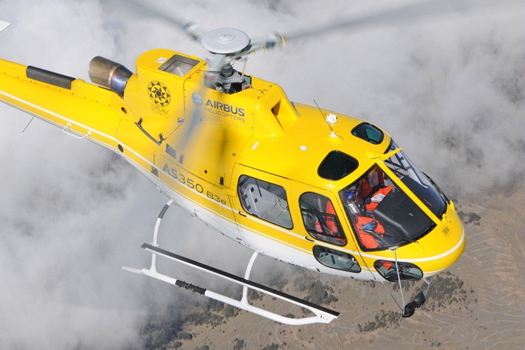
The FAA is now requiring operators of dual-hydraulic AS350 helicopters to perform their yaw load compensator checks after rotor shutdown. Airbus Helicopters Photo
Two months after Airbus Helicopters introduced new hydraulic test procedures for AS350 helicopters, the United States Federal Aviation Administration (FAA) has made test procedure changes mandatory for operators of dual-hydraulic AS350 models.
The FAA issued an initial Emergency Airworthiness Directive (AD) on the subject on Oct. 28, 2015, and a revised version of the AD two days later. The revised AD, 2015-22-53, requires operators of dual-hydraulic AS350 helicopters to stop performing the yaw load compensator check during pre-takeoff procedures, and instead perform it after landing, following rotor shutdown. The AD also requires that the collective-mounted yaw servo hydraulic switch be in the “ON” (forward) position before takeoff.
According to the FAA, the AD was prompted by two accidents and one incident involving dual-hydraulic AS350 B3 helicopters. In each event, the aircraft experienced a counterclockwise rotational yaw immediately after takeoff. The pilots in the two nonfatal events reported that the anti-torque pedals felt jammed or locked in the neutral position, which is indicative of takeoff without hydraulic assistance to the tail rotor. This can occur if a pilot drains the yaw load compensator during pre-takeoff hydraulic checks, and then neglects to restore the collective-mounted yaw servo hydraulic switch to the “ON” position.
The problem has been recognized for some time. In August 2014, Airbus Helicopters issued a safety notice on the topic after receiving reports of pilots taking off with their collective-mounted yaw servo hydraulic switches in the “OFF” (aft) position. Airbus also introduced a modification (07.4622) for dual-hydraulic AS350 models, which provides pilots with a flashing caution light when the yaw servo hydraulic switch is turned “OFF”. However, relatively few AS350 operators undertook the retrofit in a timely fashion; one year later, at least two-thirds of the eligible aircraft in the U.S. fleet still lacked the modification.
On July 3, 2015, a Flight For Life AS350 B3e was involved in a fatal crash shortly after takeoff in Frisco, Colo. The survivors of that accident filed lawsuits against Airbus Helicopters and operator Air Methods Corp., contending that the aircraft took off without hydraulic assistance to the tail rotor. On Aug. 26, 2015, Airbus Helicopters announced new yaw load compensator functional check procedures for all AS350 models in the form of flight manual revisions. The revised procedures were immediately adopted by the European Aviation Safety Agency as an AD with an effective date of Aug. 31, 2015.
The FAA’s new, revised Emergency AD does not require adoption of the procedures as published by Airbus Helicopters. Instead, operators of dual-hydraulic AS350 helicopters may comply by inserting a copy of the AD into the rotorcraft flight manual, or by making specified pen-and-ink changes to procedures in the manual. The complete AD is available on the FAA website.
The earlier version of the AD did not include a method of recording compliance. It also contained an inaccurate statement regarding the operation of the yaw load compensator system. A fuller explanation of how the system works can be found in previous Vertical coverage and in Airbus Helicopters Safety Information Notice No. 2776-S-29.









